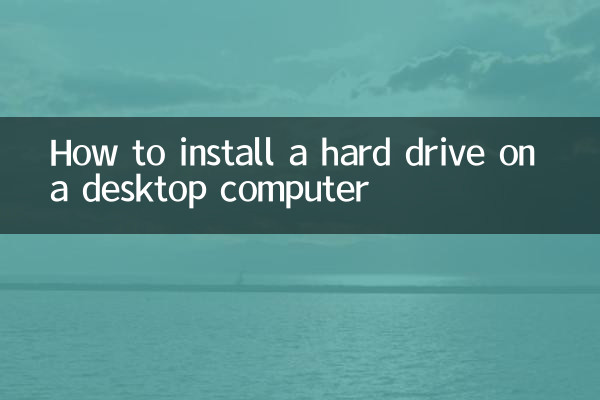How to install a hard drive on a desktop computer
In today's digital era, the demand for data storage is growing day by day, and adding a hard drive to a desktop has become a necessity for many users. Whether you are upgrading an old device or expanding storage space, installing a hard drive is a highly practical operation. This article will combine the hot topics and hot content on the Internet in the past 10 days to provide you with a detailed introduction to the steps, precautions, and answers to frequently asked questions about installing a hard drive on a desktop computer.
1. Preparation work

Before starting the installation, make sure you have the following tools and materials ready:
| Tools/Materials | illustrate |
|---|---|
| harddisk | SSD or HDD, choose capacity and type according to your needs |
| SATA data cable | For connecting hard drive and motherboard |
| screwdriver | Securing the hard drive and chassis |
| power cord | Make sure the power supply has enough SATA power supply interfaces |
2. Installation steps
1.Turn off power and open the case: First turn off the computer and unplug the power cord, then use a screwdriver to open the side panel of the case.
2.Locate hard drive location: Find the hard drive installation location inside the case, usually under the front of the case.
3.Fixed hard drive: Insert the hard drive into the hard drive bay and use screws to fix it on the chassis.
4.Connect data cable and power cable: Connect one end of the SATA data cable to the hard drive and the other end to the SATA interface on the motherboard; connect the SATA power supply interface of the power cord to the hard drive.
5.Check connection: Make sure all connections are tight and not loose.
6.Close the case and turn it on: Reinstall the chassis side panel, connect the power supply and turn on the computer.
3. Hard disk initialization and partitioning
The newly installed hard disk needs to be initialized and partitioned in the operating system before it can be used. The following are the steps for Windows systems:
| step | Operating Instructions |
|---|---|
| 1 | Right-click "This PC" and select "Manage" |
| 2 | Select "Disk Management" in the "Computer Management" window |
| 3 | Find the new hard drive, right-click and select "Initialize Disk" |
| 4 | Choose partition style (MBR or GPT) |
| 5 | Right-click on the unallocated space and select "New Simple Volume" |
| 6 | Follow the wizard to complete partitioning and formatting |
4. Frequently Asked Questions
Based on the popular search data in the past 10 days, we have compiled several issues that users are most concerned about:
| question | solution |
|---|---|
| The system cannot recognize the new hard drive | Check the data and power cable connections; initialize the hard drive in Disk Management |
| Computer cannot start after installation | Make sure the original system disk is connected correctly; check the startup sequence |
| Hard drive is noisy | Check whether the fixing screws are tightened; there will be a slight sound when the mechanical hard drive is working normally. |
| Slow transfer speed | Check if connected to SATA 3.0 interface; consider upgrading to SSD |
5. Comparison between SSD and HDD
Based on recent hot topics, we have compiled the main differences between SSD and HDD:
| Comparative item | SSD | HDD |
|---|---|---|
| speed | Fast (above 500MB/s) | Slow (100-200MB/s) |
| price | More expensive | Cheap |
| Durability | Limited number of writes | Mechanical structure is easily damaged |
| noise | none | have |
| calorific value | Low | higher |
6. Purchase suggestions
Based on recent e-commerce platform sales data and user reviews, we give the following purchasing suggestions:
1.system disk: It is recommended to choose an SSD of 250GB or more to improve system response speed.
2.storage disk: Large-capacity HDD (above 1TB) is more cost-effective and suitable for storing film and television materials.
3.Brand selection: Western Digital, Seagate, Samsung, Kingston and other brands have reliable quality and guaranteed after-sales service.
4.Interface type: Pay attention to the interface type (SATA or M.2) supported by the motherboard to avoid purchasing incompatible products.
7. Summary
Installing a hard drive in a desktop computer is a relatively simple operation, but it requires attention to detail. With the structured guidance in this article, even computer novices can successfully complete the installation. It is recommended to back up important data before operation. If you encounter problems that cannot be solved, you can seek professional help. SSD prices have continued to fall recently, which is a good time to upgrade computer storage. You can choose a suitable storage solution according to your own needs.

check the details

check the details